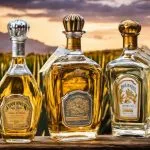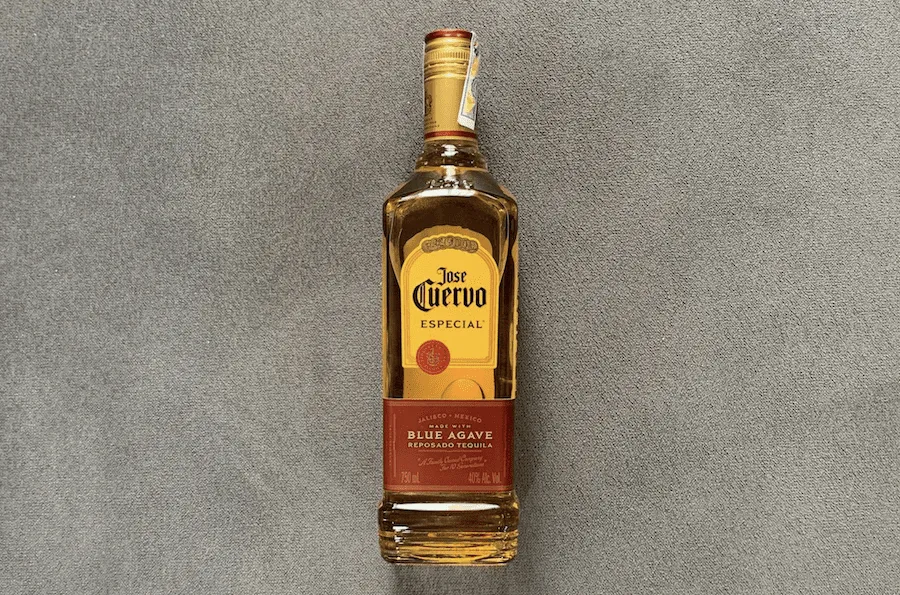1800 Tequila is owned by the Beckman family, the same family that owns the Jose Cuervo brand. The 1800 brand was launched in 1975 but named after the year 1800, which, according to legend, was the first year in which Tequila was successfully aged in wood. 1800 comes in distinctive trapezoidal bottles intended to resemble Mayan pyramids and has marketed itself as a top-shelf sipping tequila, positioning itself as a solid alternative to Patron. Though 1800 makes a fine alternative to Patron if you’re ripping shots at a club, many bartenders and tequila enthusiasts will tell you that there are superior bottles out there for similar prices.
1800 Tequila Price List 2022
| Type | Size | Price | ABV |
|---|---|---|---|
| 1800 Silver Tequila | 375ml | $13.99 - $15.99 | 40% |
| 750ml | $20.99 - $28.99 | ||
| 1L | $33.99 - $38.99 | ||
| 1.75L | $39.99 - $54.99 | ||
| 1800 Reposado Tequila | 750ml | $20.99 - $27.99 | 40% |
| 1800 Coconut Tequila | 750ml | $22.99 - $29.99 | 35% |
| 1800 Anejo Tequila | 750ml | $33.99 - $44.99 | 40% |
| 1800 Cristalino Tequila | 750ml | $54.99 - $59.99 | 40% |
| 1800 Milenio Extra Anejo Tequila | 750ml | $199.99 - $255.02 | 40% |
Is 1800 Tequila Worth the Price?
I don’t personally think any products in the 1800 line are fantastic value. You can find more authentic, higher-quality tequila for much less. Look for Espolon, Olmeca Altos, Cimmaron, Arrette, Ocho, Fortaleza, El Tesoro, etc. For a bottle that is a really great deal in terms of price vs. quality, consider Tapatio Blanco shines.
Alternatives to 1800 Tequila at Comparable Prices
1800 is not a bad Tequila, but I wouldn’t call it anything special either. It’s fine for a night out on the town, or in a cocktail or two if that’s what’s on the menu, but there are many alternatives that are higher quality for similar prices. I’ll introduce a few of those brands below.
- Patron
First off, I have to mention Patron which is sold from $37.99 onwards. Owned by Bacardi, Patron is probably the second most widely recognized name in Tequila (After 1800’s parent Jose Cuervo). Bottled at 40% ABV, Patron is similar to 1800 in many other ways as well. First off, both are marketed as top-shelf Tequilas, both are at least partially made using diffuser methods, and both are surpassed in quality by lesser-known and less expensive brands. As with 1800, you could do a lot worse than drinking Patron in your margarita, and at many bars Patron or 1800 may simply be the best available option for Tequila. However, there are better buys for your home bar if you’re willing to search for them.
[middle1]
- Espolon
Espolon is one of those “better buys” I mentioned earlier. It’s usually priced a few dollars cheaper than Patron or 1800, yet is not made using a diffuser and is similar or even superior in quality. Espolon is made with 100% Blue Weber Agave. It is owned by the Campari Group, bottled at 40% ABV from NOM 1440 in Los Altos, Jalisco, and available in Blanco, Reposado, Anejo, and Anejo X bottles.
- Olmeca Altos
Another great product for those looking to dive into good tequila without breaking the bank, the Olmeca Altos line is also made with 100% Blue Weber agave does not use a diffuser, and is made in Jalisco at NOM 1111. Owned by Pernod Ricard, Olmeca Altos is the mid-range in an entire Olmeca family of Tequilas. Don’t confuse it with the plain old “Olmeca” Tequila, which is mixto and of sub-par quality. Olmeca Altos and Olmeca Tezon are high-quality tequilas made using 100% blue weber agave and without the abuse of the diffuser method. Olmeca Altos is available in Plata (Blanco), Reposado, and Anejo bottles.
[both]
- Tapatio
Don’t confuse it with the similarly named hot sauce. Tapatio is an absolute steal considering the quality and price. A whole liter size bottle can often be had for less than 35 dollars. Tapatio is made in smaller batches using traditional methods and imported to the USA by Charbay. Not only do they have the classic Blanco, Reposado, and Anejo available, but they also bottle a 55% ABV version of their Blanco if you’re looking for something with a little more kick.
- Others
While the four alternatives mentioned above are most comparable to 1800 in price and quality, there are many premium tequilas far superior to 1800 or Patron available in the US market. Many of these brands come at a higher price point than 1800 (Some quite significantly higher), but if you’re willing to splurge they are worth it. If you’re looking to discover the nuanced flavors of premium tequila I suggest looking for brands such as Fortaleza, Pasote, El Tesoro, G4, Clase Azul, or Don Julio 1942. Surprisingly, many of these brands can be found for a more than fair price at Costco, along with some really solid Scotch whiskeys.
[middle1]
Reviewed: 1800 Tequila Product Line

- 1800 Silver
The flagship of the brand, 1800 Silver, is likely the 1800 product most familiar to you. Double distilled and rested for two weeks in oak barrels, 1800 has a slight peppery note to it, and some describe it as sweet or even a bit fruity. While 1800 claims to be 100% Blue Weber agave, it is still branded as “Silver” rather than as Tequila Blanco. This could be for marketing purposes, or to make it more easily comparable to Patron, which also goes by “Silver” over Blanco. However, this can cause some confusion, as “Silver” is sometimes used to describe mixto tequila, which does not meet the requirements of Blanco tequila.
- 1800 Reserva Reposado
[both]
Departing from the “Silver” branding on the unaged 1800 bottle, 1800’s aged offerings go by Reposado and Anejo instead of “Gold”. 1800 Reposado is aged for six months in French and American oak barrels before being bottled at 40%ABV. The taste is describable as peppery or spicy, with notes of oak and a dry finish.
- 1800 Reserva Añejo
The majority of 1800 Reserva Añejo is aged in French oak for at least 12 months and a smaller fraction is aged in American oak for up to three years. The two are then blended together and bottled at 40%ABV. You can really taste the oak in this bottle, so much so that it partially obscures the peppery spice and most of the vegetal notes of agave left over after distillation.
- 1800 Coconut
[middle1]
1800 Coconut was launched in 2012, and at the time was the first coconut-infused Tequila on the international market. Bottled at a slightly lower 35% ABV than the other 1800 products, the 1800 coconut is infused and sweetened with “natural coconut flavor”. Notes of fresh agave, spice, and of course coconut are the primary flavors at play here. 1800 suggests paring their coconut Tequila with pineapple juice.
- 1800 Ultimate Margarita
1800 Ultimate Margarita is a pre-mixed cocktail made by 1800 and bottled at 9.5% ABV. It is available in original, raspberry, peach, watermelon, jalapeno lime, mango, and pineapple flavors. In 2006, at the time of launch, it was the only pre-mixed bottled margarita product to use 100% blue weber agave, however, bottles no longer carry that claim, and now instead boast being made with “Premium Tequila”. Regardless of the quality of Tequila used, a classic margarita made by hand at a bar will usually be between 20-30% ABV so this pre-mixed margarita is fairly weak compared to a classic marg. You may want to spike this with a bit more Tequila if you’re used to traditional margaritas.
[middle1]
Cocktails
So you’ve got your bottle of Tequila and some limes. Your friends are coming over tonight and you want to offer them something else beyond shots or classic margaritas. Here are a few suggestions to explore.
The Paloma
- 60 ml Blanco or Silver Tequila
- 15 ml freshly squeezed lime juice
- Grapefruit Soda such as Ting or Jarritos
Add tequila and lime juice to a tall glass with ice, top with grapefruit soda of your choice, and stir lightly. Garnish with a lime wheel. This drink is a great next step in exploring Tequila cocktails if you enjoy margaritas but are in the mood for something new. The Paloma is sometimes said to be even more popular than the margarita in Mexico. If you’re looking to spice things up, muddle a slice or two of jalapeno in the bottom of your glass, or rim the glass with a mixture of salt and Tajin seasoning. You can also use fresh-squeezed grapefruit juice, soda water, and a little simple syrup to substitute for grapefruit soda if you can’t find any at the store.
[middle1]

The Rosita
- 45 ml Reposado Tequila
- 15 ml Sweet Vermouth
- 15 ml Dry Vermouth
- 15 ml Campari
- 1 dash Angostura bitters
Stir all over ice, strain over a large cube or rocks, garnish with an expressed orange or a lemon twist. This drink is a riff on a classic negroni, with a lot of swaps and ratio adjustments. You can expect a similar bitter flavor profile, with more of the tequila shining through. After you try the classic recipe above, I suggest playing around with it a bit. Use Punt e Mes sweet vermouth, split the tequila base with a little mezcal, replace Campari with Aperol, and use a dash of chocolate bitters for an equally delicious but slightly more complex take on the Rosita.

1800 Tequila Production
[both]
1800 is produced at Jose Cuervo’s La Rojeña distillery (NOM 1122) in Tequila, Jalisco, Mexico. As with many of the Cuervo family of tequila products, 1800 is at least partially produced using a diffuser method. This method extracts all distillable material from an agave plant and is much more efficient than traditional brick ovens or autoclaves. However, the diffuser method is looked down on by tequila aficionados as it destroys the unique taste of agave, incentivizes the use of immature agave plants, and results in a less flavorful distillate similar to vodka which must then be adjusted with additives. While superior to a mixto tequila, diffuser tequilas are often regarded as inferior to those made with an autoclave or best of all using a Tahona and traditional brick ovens.











You can love sports betting on the net not only on desktop but on mobile devices,
as well.